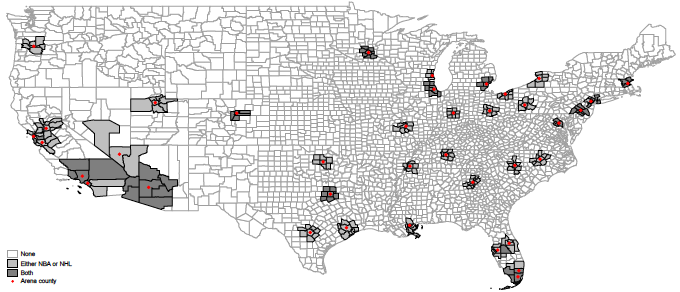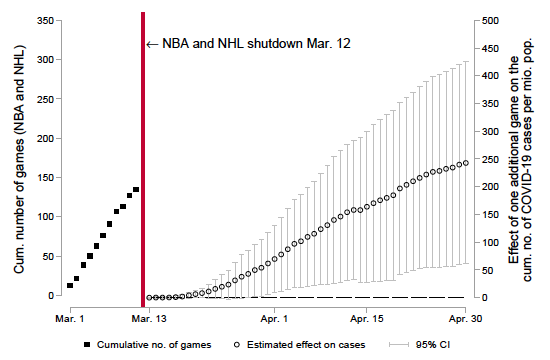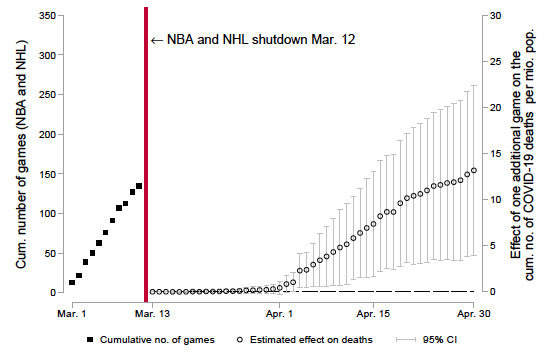Yves here. This analysis of Covid-19 transmission is clever as well as important, since the findings are dramatic. And of course, the exceptional US is the source of the data.
By Alexander Ahammer, Assistant Professor, Johannes Kepler University Linz, Martin Halla, Professor of Economics, University of Linz and Mario Lackner, Assistant Professor, University of Linz. Originally published at VoxEU
Social distancing is important to slow the community spread of COVID-19. This column studies the banning of mass gatherings, a comparably low-cost intervention. Exploiting exogenous variation in top-flight basketball and ice hockey games in the US, which arise due to the leagues’ predetermined schedules, and the suspension of the 2019-20 seasons, it estimates the impact of indoor mass gatherings on COVID-19 mortality in affected US counties. The findings suggest that one additional mass gathering increased the cumulative number of COVID-19 deaths in affected counties by 9%.
Due to the lack of vaccines and effective antiviral drugs, countries have to rely on a set of non-pharmaceutical interventions (NPI) in response to the COVID-19 pandemic. One important public policy to promote physical distancing is to ban mass gatherings (Memish et al. 2019, Baldwin and Weder di Mauro 2020a). Such events may foster contagious disease transmission as a result of large crowds being in close contact, often for extended periods of time. A temporary mass gathering ban is relatively cheap and easy to implement compared to, for example, school or workplace closures (Baldwin and Weder di Mauro 2020b). In response to the spread of SARS-CoV-2, the pathogen leading to COVID-19, several prominent events had been cancelled, or postponed, even before widespread quarantine measures were enacted (McCloskey et al. 2020), including religious, cultural, and sporting events.
Evidence from Indoor Venues: NBA and NHL Games
In Ahammer et al. (2020), we quantify how National Basketball Association (NBA) and National Hockey League (NHL) games have contributed to the spread of COVID-19 in the US. Both leagues play exclusively in indoor venues, which present a high-risk setting for infectious disease transmission. Before play was suspended on 12 March, up to 12 games per league with an average audience of about 18,000 people were held each day. We analyse how much the number of games held between 1 March and 11 March has contributed to the community spread of COVID-19 in counties surrounding NBA and NHL venues.
Figure 1 NBA and NHL venues and adjacent countries in the US

We use information on NBA and NHL games played between 1 March and 11 March. During this time span, 78 NBA games (about seven per day on average) and 57 NHL games (five per day on average) were played in US venues. Both leagues suspended all remaining games for the 2019/20 season indefinitely on March 12. In our analysis, we focus on 38 counties which host either a NBA or a NHL venue, or both, and all their 204 neighbouring counties, which we call the ‘perimeter’ (see Figure 1). For all affected venue and perimeter counties, we collect information on COVID-19 cases and related deaths. We then relate the number of the cumulative number of games (NBA and NHL) between 1 and 11 March to the cumulative number of COVID-19 cases and deaths per one million population measured on different dates.
Empirical Identification Due to Pre-Defined Game Schedules
Since the game schedules were determined long before the first COVID-19 case became public, their spatial and temporal distribution should be unrelated to the initial spread of COVID-19 in the US. The first known case in the US was a man in Washington State who returned on 15 January 2020 from Wuhan. The 2019/20 NBA schedule had been released on 12 August 2019, the NHL schedule on 25 June 2019. Game schedules are not correlated with observable county characteristics and ticket sales did not systematically change until the NBA and NHL suspended play.
One Additional Mass Gathering Increased COVID-19 Deaths by 9%
Figure 2 displays our estimation results, where each estimate comes from a separate regression, with the dependent variable being measured on different days. A priori, we expect effects to be strongest around 3 weeks after the shutdown. This is precisely what we find. The effect of games starts to pick up around 28 March and increases at a decreasing rate since then. This is true for both cases and deaths. Furthermore, we see that cases respond earlier than deaths, which makes sense given the natural lag between diagnosis and death. Our estimates suggest that one additional indoor mass gathering between 1 and 11 March in the form of an NBA or NHL game increased the cumulative number of COVID-19 cases (measured on 30 April 2020) in affected counties by at least 243 per one million population (p<0.01), or 8.3%, and the number of COVID-19 deaths per million by 13 (p<0.01), or 8.9%. Our results are based on population-weighted regressions. Unweighted estimations provide similar conclusions.
Figure 2 Estimated effect of games on confirmed cases (top panel) and deaths per million population (bottom panel)
a) Confirmed cases per million population

b) Deaths per million population

Effects Are Larger in Densely Populated Areas and in Colder Regions
We also explore the heterogeneity of effects across different counties (results not shown). We find that effects are stronger in areas with high population density and in counties with below-median temperatures. Both dimensions of treatment effect heterogeneity are in line with our expectation. First, if people live close to one another, the risk of transmission is greatly increased. Second, it is assumed the virus replicates more easily in lower-temperature conditions. We do not find different treatment effects across counties with different demographic compositions. This is surprising, given that early reports in the medical literature suggest that Black people tend to be affected more strongly by COVID-19 than other ethnic groups (Yancy 2020).
Policy Conclusions
We conclude that banning mass gatherings is an effective NPI to slow the spread of COVID-19. We suggest that public health officials recommend cancelling or postponing mass gatherings during COVID-19 and future pandemics. Our results do not speak to outdoor mass gatherings, where the risk of disease transmission may be lower. For example, recent evidence (Sabia et al. 2020) suggests that Black Lives Matter protests in the US did not contribute significantly to COVID-19 spread.
See original post for references


one problem with this analysis….and it’s not that i disagree with the conclusion….but college basketball is also quite popular with the top programs drawing comparable crowds to an NBA game.
I don’t know if this article has been posted here, but its most excellent.
https://vtdigger.org/2020/06/10/spread-of-covid-19-from-uvm-game-more-extensive-than-thought/
My guess is the regularity of games and the makeup of the fans is easier to track. With a mass gathering in Burlington, where are people coming from? Where did people come from for the Louisville-UVA game in Charlottesville on March 5th? which was a Saturday versus a midweek game? Do the numbers from Richmond and Nova rise and fall due to weekend and midweek games? Hence spreading should be a problem. UVA is basically always full during conference season. Maybe it’s stable and more local than anything. Then of course, there are places like FSU and Miami which have dozens of fans at games.
Dear 6AM
What you have stated as a problem with this analysis is not a problem with this analysis at all. The analyst was looking at data for a limited number of NHL and NBA games during a limited number of days and showing the likely results. He/she was not analysing college games at all. It may be worthwhile to do that, even expanding to more than one team in one venue. Could you suggest that to people in the field in Vermont?
One valuable note you have made, is the likelihood for the NHL and NBA analysis that the analyst was not able to get a really complete picture because of lack of testing, coupled with lack of recognition of symptoms and fear of seeking medical help. Any or all of these is liable to increase the infection transmission rate, painting an even darker picture of mass gatherings..
“Effects Are Larger in Densely Populated Areas and in Colder Regions”
This one isn’t quite right. I definitely can see why the effects would be larger in densely populated areas (more people close together means more opportunities for sharing), but the comment about colder regions should really be a comment about extreme temperatures.
A good chunk of the US south has seen a big increase of COVID-19 cases over the past couple of months, and one factor driving this is the tendency of people to stay indoors more to avoid the heat: https://news.harvard.edu/gazette/story/2020/06/air-conditioning-may-be-factor-in-covid-19-spread-in-the-south/.
“The states that, in June, are already using a lot of air conditioning because of high temperatures are also the places where there’s been greater increases in spread of COVID-19, suggesting more time indoors as temperatures rise. The same [thing] happens in wintertime, with more time indoors.”
More people indoors is bad is two major regards. It means more people in close proximity to each other and more opportunities for sharing. And it means breathing more re-circulated (or even flat-out stagnant) air.
This is pretty awful news for many professional sports. Road cycling is maybe the only pro sport that doesn’t depend on paying crowds to keep them going. It could mean empty stadiums for a year. Given the extraordinary transfer fees soccer players are going for this summer in Europe (especially in England), you’d wonder if this has sunk in yet with the clubs.
They may be relying on the fact that most are ‘outdoor’, but its hard to see how you deal with interior choke points in stadiums, especially toilets. The would need a complete redesign for safety, and thats not viable.
I’ve really been wondering about how the NHL is going to deal with this as it stretches into next year. I’ve always heard the NHL described as a “gate-revenue driven” league because they don’t have the big TV deals that some of the other major sports have. But having refrigerated indoor arenas with 20,000 spectators doesn’t seem like a particularly safe situation for the foreseeable future. Now they’re playing some weird condensed playoffs in Edmonton and Toronto in front of empty stadiums in August! I don’t have any idea what they’ll do if some players or staff test positive.
to rusti
So far so good, apparently. Both the NBA and the NHL are reporting much bigger TV audiences than normal playoffs, even. So you can tune in from your rec room couch…sofa so good. The NBA has lost one “fanny” though. Donald Trump claims he will watch no more games because players are offending his sense of decency and patriotism be taking a knee during the playing of the car strangled spanner. In response, the basketball king, Lebron, says he won’t be missed.
As for cases, the two leagues have determined to play games within bubbles, something baseball and US football and soccer cannot do. I’d not be confident of accurate reporting of reasons for players suddenly being not dressed for games. i don’t watch much sports anymore; I don’t know a lot about basketball, except that my oldest son-in-law played against Steve Nash in high school in BC. The television commentators for NHL games are either team touts or league touts, so the level of reporting reflects that. But, the NHL tournament is being played in Canada, where hockey is like a drug; the fandom is satiating itself after their period of withdrawal. The result will, among other things, reduce the level of spousal abuse.
Well, you got your health concerns and then you got the Economic Concerns:
https://www.heraldonline.com/sports/high-school/article244651017.html
Our City Leaders have decided, and that’s how they are rolling us. Hear their own words:
We’re putting anywhere from (8,000) to 14,000 people in Rock Hill on a given weekend, and what that does is it ramps us up quicker to recovering from the coronavirus issue that we had a few months ago, when things were just at a standstill,” said Billy Dunlap, the CEO of tourism group Visit York County. Dunlap said hosting these tournaments has “put us in a position where we are ahead of most destinations because we’re able to hold these types of events.”
Rock Hill Mayor John Gettys said hosting these events is important, considering the investments the city has made for decades to cultivate its sports tourism industry.
“I think for our community, they’re necessary,” Gettys said.
1,175 Positive tests and 50 new deaths in SC yesterday.
Don’t have time for the careful read needed, but I’m wondering–since the authors are puzzled by a lack of additional increased infections among Black people–if they assume that NBA stadiums are filled with Black people?
At least during the playoffs, when I watch, fans tend to be predominantly white.
I think the authors are conflating black people with poor people.
Like Joe Biden? “Poor kids are just as smart as white kids!”
Coronavirus just loved cold air and people mingling together in lift lines @ ski resorts, or following somebody’s breath trail on a chair lift.
I was amazed at how little caution there was in the 1 NHL game I watched last week. The only person wearing a mask was the penalty box minder, that’s it.
would it be fair to infer that NFL ( outdoor) and College Football ( outdoor) with fans is OK?
I’m wondering as well if they back out nursing home and assisted living deaths do their #’s stand up?
Let us not forget the ongoing Sturgis motorcycle rally, which has led to this pithy headline,”Great Touring Bike Deals Coming To An Estate Sale Near You, Sturgis Motorcycle Rally Hopes To Welcome 250,000.”
¼ million people in a very small town, and then they all drive home.
Good times.
What does this import for effects of mass protests?
1. They are outdoors. Covid infection risk low to non-existent in outdoor settings. No evidence whatsoever that BLM protests increased infections
2. Protestors can wear masks and engage in some social distancing too. A lot of the BLM marches showed more spacing between people than I have seen in other marches.